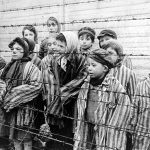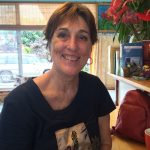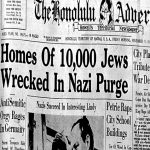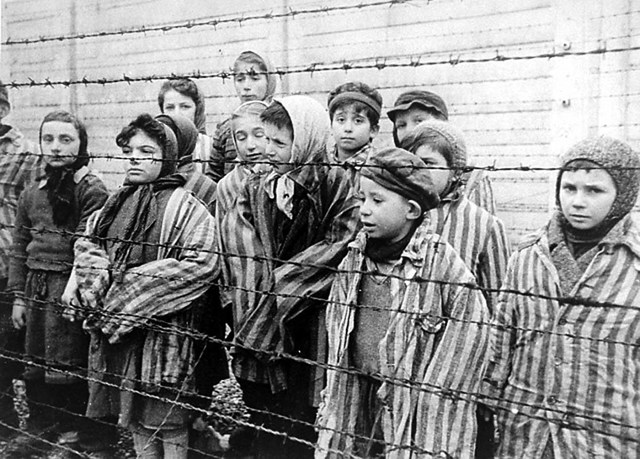Bo Breda can still conjure up stories she heard as a child — first-hand accounts from Holocaust survivors, only a few years after World War II ended.
Breda lived in a building with European refugees, located in the South Bronx of New York City in a predominantly Jewish neighborhood.
When Breda was 5, her family installed their first television. She remembers graphic footage of emaciated, deceased concentration camp prisoners being tossed into trenches.
The now 70-year-old Breda said “the idea of mass deaths, that is, the idea of not killing people one at a time, but killing them as a group,” was most impactful to her.
She grew up to have a career as a college professor and a textile designer. She’s since retired in Pahoa.
She wasn’t raised Jewish, but those early memories helped her foster a love for the religion, prompting her to convert as an adult.
And now, her faith has led her to help national scholars better outline the historical record of the mass genocide more than 70 years ago. Breda is among hundreds nationwide contributing to a national Holocaust project spearheaded by the Washington, D.C.-based U.S. Holocaust Memorial Museum.
The project, “History Unfolded,” is a collection of historical newspaper articles compiled in hopes of better understanding how American newspapers reported about the Nazi persecution and killing of Jews.
Breda’s initial article submission is among more than 2,000 in the project collection so far, and yet the only one from a Hawaii newspaper. The project wants more residents in Hawaii to contribute.
“For folks in Hawaii, this is an opportunity to see what kind of information was available to Hawaii (residents) at the time,” said David Klevan, education lead for the project. “It’s learning how people in Hawaii were responding to the threat of genocide as it was emerging in Europe.”
Klevan said scholars haven’t studied small-town news coverage of the Holocaust much — most research has centered around major newspaper coverage. Project leaders hope the article collection will eventually serve as a research tool for students and educators, Klevan said.
Breda submitted a Honolulu Advertiser article she found in the University of Hawaii at Hilo library’s microfilm collections. The article was about the anti-Jewish riots known as Kristallnacht.
“I was pleasantly surprised about the amount of coverage I saw (in Hawaii newspapers),” Breda said. ” … (The project) gave us suggestions (of events to research), but I found stories that were even different about the Nazis and the Jews. Things they didn’t even know had happened.”
It’s difficult to know how many Hawaii residents were identified as Jewish during World War II — the islands were not yet part of the United States — but historical accounts suggest that numbers were likely marginal. Some accounts show Jewish traders first came to the islands in the 1800s.
By 1902, there were roughly 100 Jewish people living in Honolulu and around 40 scattered throughout the Neighbor Islands, one article states.
Today, the state’s Jewish population hovers around 10,000, which is largely based on Oahu. Between 800 to 1,000 Jewish people live on Hawaii Island either full or part-time, according to Barry Blum, past president of Kona Beth Shalom, an unaffiliated Jewish congregation in West Hawaii. Most are not affiliated with any congregation, though the Big Island is home to several Jewish communities.
Years ago, Hilo even had a congregation called “Temple Aloha,” Blum said, though it’s since disbanded. Several Holocaust survivors have also resided in the past on the Big Island, Blum said.
“(Hawaii has) as slight a Jewish footprint as any state (in the country),” said Jeffrey Kapali Lyon, chair of the UH Department of Religion on Oahu. “(Jewish people) have tended to live in the presence of a good, strong Jewish community and in a lot of places those have been larger cities. While there’s a footprint in Honolulu and now in Kona, there’s never been a large enough cluster of population to make (a formal congregation) happen in Hilo. That’s true in a lot of western states — when there’s a very large Jewish population, it’s generally focused around cities.”
Breda is among a small group of East Hawaii residents who meet regularly in Pahoa for Torah studies. The group is soon hoping to find a more central spot to meet in Hilo.
Breda said she’s also planning to submit more articles. The project will continue collecting submissions through 2018, when stories will be made part of a new exhibition.
More information can be found at newspapers.ushmm.org.
Email Kirsten Johnson at kjohnson@hawaiitribune-herald.com.











